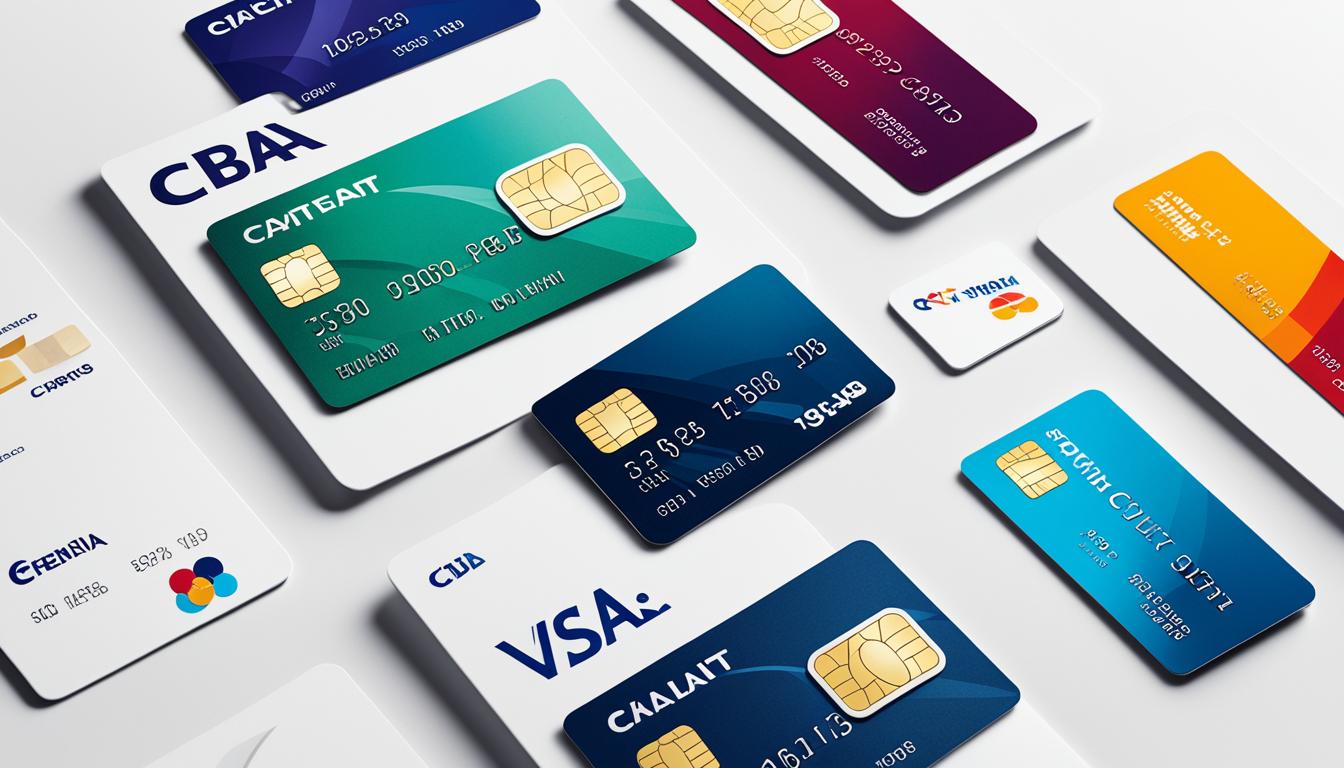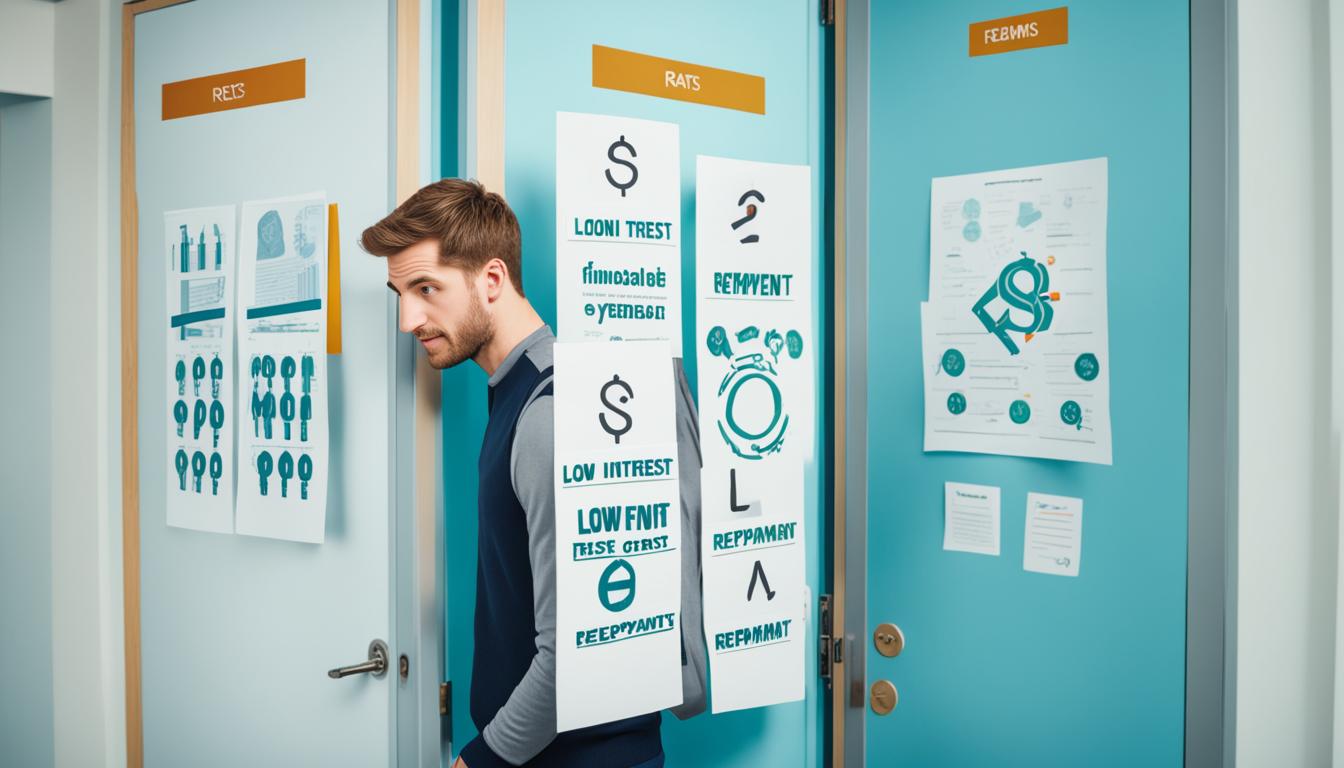A student loan lets someone borrow money to pay for college from the U.S. Department of Education or a private lender. Borrowers pay the money back with interest over time. It’s a key way for students to get their education paid for.
These loans help cover what college costs beyond what students and their families can. They pay for things like classes, books, a place to live, and more. This way, students can focus on their education without worrying about money too much.
There are loans from the federal government that usually have better terms than private loans. But, sometimes private loans are needed. This is especially true if you don’t qualify for government help or need more money than they can give.
Key Takeaways:
- A student loan is money borrowed to pay for college expenses.
- Student loans can be obtained from the U.S. Department of Education or private organizations.
- Repayment of student loans is required, typically with interest.
- Student loans are essential for individuals seeking to finance their education.
- Understanding the different types of student loans available is crucial when making borrowing decisions.
How Do You Get a Student Loan?
Many students choose a federal student loan to pay for school. You start by filling out the Free Application for Federal Student Aid (FAFSA). This form helps check if you’re eligible for financial help.
After you submit the FAFSA, the government looks at it. They will tell you how much you can borrow. This amount depends on your needs and the costs of your school.
When you get your aid letter, it’s key to know what it says. It shows grants, scholarships, work-study, and loans you can get. Be sure to check the loan details and how you’ll pay it back.
Think hard before taking a student loan. Check how much you really need. Loans have to be paid back with interest, so only borrow what you have to.
By applying for a loan, doing the FAFSA, and understanding your aid letter, you’ll make smart choices. This will help you pay for school and reach your education goals.
Do Student Loans Need to Be Paid Back?
Yes, student loans need to be repaid, with interest. It’s a financial obligation after graduating or leaving college. While paying back may seem hard, know there are ways to manage repayment.
After school, you usually have six months before starting to pay. This time helps you find a job and get on your feet. But, remember, interest might still add up on what you owe. So, know your loan’s details well.
When the six months are up, working with a loan servicer is key. They’re there to help you figure out how to pay back. Keeping in touch with them is vital. Let them know if your info or financial situation changes.
Before you get the loan, you must sign a Master Promissory Note (MPN). This note lays out how you’ll pay the money back, when, and with what interest rate. By signing, you agree to stick to these terms.
Loan Repayment Options
You have a few options for repaying your student loan. It’s important to look at these and pick what fits your financial situation well:
- Standard Repayment Plan: You make fixed payments over 10 years.
- Graduated Repayment Plan: Payments start smaller and increase over time.
- Income-Driven Repayment Plans: Your payment amount depends on your income and family size.
- Extended Repayment Plan: This option lowers your monthly payments by extending the payback period.
Choosing the right plan is crucial. Your choice should depend on your financial health and goals. Always stay up to date with your payments to avoid trouble.
Next, we’ll look closer at how common student loans are and their effect on students.
Is it Normal to Get a Student Loan?
Many college students use student loans to pay for school. Over half of students at U.S. public and private non-profit colleges take out loans. These loans help cover college costs.
Today, it’s hard to pay for college without help. Tuition keeps increasing. This makes it tough for families to cover all school expenses. Even with scholarships and savings, it may not be enough.
Student loans are key in helping students reach their academic goals. They support students in joining programs, learning new things, and preparing for future jobs. Loans offer vital financial support.
But, it’s crucial to handle student loans with care. College students should think hard about how much they need to borrow. They should also consider how they’ll pay it back. Managing loans well is the key.
Knowing that many students use loans shows the importance of being smart about borrowing. Good planning can help students achieve their educational dreams. It ensures they succeed in their careers later on.
What are the Types of Student Loans?
There are many student loan options for paying for college. It’s key to know these choices to manage your money wisely for school. We’ll look at federal loans and private loans, the two main types.
Federal Loans (Direct Loans)
The U.S. Department of Education is behind federal loans, or Direct Loans. They come with key benefits like set interest rates, varied ways to pay back, and safety nets for borrowers. Under the Direct Loan program, there are three kinds:
- Direct Subsidized Loans: For those in financial need, these loans help by having the government cover interest while you’re in school or delaying payments.
- Direct Unsubsidized Loans: You don’t need to show financial need to get these loans, but you have to cover the interest costs while studying.
- Direct PLUS Loans: With a bit higher interest rate, these are for grad students, professionals, or parents of undergrads. They can borrow up to the full cost of attending.
To access these loans, you fill out the FAFSA form. It assesses your financial situation and then calculates your loan amount.
Private Loans
Banks, credit unions, and online lenders offer private student loans. These differ from federal loans in their terms and conditions. The interest rates on private loans might change depending on your credit score.
Checking the fine print on private loan terms, like interest rates and how you’ll pay back, is crucial. Keep in mind, federal loans might be a better first choice than private loans.
Having learned about federal and private student loans, you’re better equipped to choose wisely. Think about what aligns best with your money situation and study plans.
Private Student Loans vs. Federal Student Loans: What’s the Difference?
When it comes to paying for school, private and federal loans work differently. It’s key to know these differences to pick the best one for you. Let’s look at how private and federal loan options compare.
Interest Rates
Federal loans come with fixed interest rates. This means the rate stays the same over time. You’ll always know how much you need to pay each month.
Private loans, however, might have interest rates that change. This can make your monthly payments go up or down. Be sure to check the agreement to see how these rates can affect you.
Repayment Options
When it comes to paying loans back, federal loans give more options. You can pick from different plans to fit your financial needs. Options like payments based on your income or paying more over time.
Private loans typically have fewer plans available. You should carefully look at what they offer. This ensures you can manage paying them back based on your budget.
Loan Consolidation
If you have multiple federal loans, you can merge them into a single payment. This makes it easier to keep track of what you owe. It’s a way to simplify how you pay back your loans.
Private loans usually don’t let you combine them into one. This is important to know if you’re considering making your payments easier. It can be more challenging with private loans.
Summary
Choosing between private and federal student loans involves looking at interest rates, paying back options, and loan merging potential. Federal loans offer stable interest rates and many ways to repay. They also allow you to combine loans into one. Private loans, though, might come with interest rates that vary and fewer options for paying back.
Knowing these basic differences is vital in making a wise decision based on your financial needs. It’s wise to extensively look into and compare your loan options before picking one.
With a better understanding of private and federal loans, it’s crucial to see if loan consolidation fits your needs. Next, we will check out the upsides and downsides of consolidating and the factors to think about when deciding.
Should You Consolidate Your Student Loans?
Consolidating your student loans can be really helpful, but think it through. This option means combining all your loans into one. Doing this makes it easier to pay off, needing just one monthly payment on your part. There are good and bad sides to this strategy, so let’s dive into them.
Pros of Loan Consolidation
- It simplifies things: Combining many loans into one means less to keep track of.
- You can pay less each month: Sometimes, extending how long you pay can lower the amount you owe each month.
- You might get a better interest rate: Switching from variable to fixed rates can save you money over the loan’s life.
- Budgeting becomes easier: A single monthly payment makes budgeting smoother, helping you manage your money better.
Cons of Loan Consolidation
- But, it could take longer to pay off: Lowering your monthly payments by extending the term means more interest over time.
- You may lose benefits: Going from federal to private loans could mean saying goodbye to helpful programs. Think about it carefully.
- Not always lower rates: Consider the rates of your current loans versus the new one to be sure you’re saving on interest.
- Less flexibility: Private loans don’t always offer the same flexible payment options as federal loans.
Think hard about your personal situation before jumping into loan consolidation. It’s key to look at how it affects your payments, interest, and benefits. Talking to money experts can guide you in the right path.
Also, remember that loan consolidation isn’t for everybody. It’s important to weigh all the benefits and risks. Make sure it fits your financial plans and needs.
| Pros of Loan Consolidation | Cons of Loan Consolidation |
|---|---|
| Streamlined Monthly Payments | Extended Repayment Term |
| Lowers Monthly Payment | Loss of Certain Benefits |
| Potential Interest Rate Reduction | Interest Rate Considerations |
| Simplified Budgeting | Loss of Repayment Options |
How Much Should You Borrow?
When thinking about student loans, it’s key to borrow smartly. Only take what you need. Make sure you think about your financial future, including what you might earn and if you can pay it back over time.
Deciding on the amount you borrow should be based on what you actually need. This helps avoid taking on too much debt later on. Look at your college costs like tuition, fees, and where you’ll live. Also, think about changes in your life that might affect your finances.
Think about how much you think you’ll make in the future as well. Research jobs to see what they pay. It’s important that the money you need to pay back is a reasonable part of what you’ll earn.
Keep in mind, what you may earn later can change. Your job’s well-paying nature could depend on the area, the job market’s state, and personal events. You could also talk to people in the field for more insight on pay.
The Federal Student Aid Repayment Estimator is a great tool to use. It gives you an idea of what you might have to pay back each month. This is based on your expected income and different repayment plans.
Making wise choices about how much to borrow is vital. Think of your current needs, what you might earn later, and if it’s possible to pay back what you owe. This way, your student loan journey will be smoother, and your financial future better handled.
| Considerations for Borrowing Student Loans: |
|---|
| 1. Evaluate your financial need and borrow only what is necessary. |
| 2. Research and forecast your future salary prospects to determine your repayment ability. |
| 3. Utilize tools like the Federal Student Aid Repayment Estimator to estimate future loan burden. |
| 4. Seek advice from career counselors or industry professionals to understand your chosen field’s earning potential. |
| 5. Create a budget and consider how student loan payments will fit into your overall financial plan. |
Conclusion
Student loans help many people afford higher education. It’s key to know your loan choices and how to pay them back. Being smart about these decisions helps you fund your education and keeps your financial future stable.
Think hard about how much money you need for school. Make sure you won’t struggle to pay it back with your future job. Also, check out plans that let you pay based on what you earn or that might forgive some of the loan.
To handle student loans well, start by making a budget. Always pay on time and talk to your loan provider if you can’t. These steps help you manage your loans wisely and reach your education goals.
FAQ
What is a student loan?
A student loan is money you borrow to pay for college. You can get it from the government or a private group. It must be paid back with extra money, called interest.
How do you get a student loan?
To get a federal student loan, fill out the FAFSA form. This form checks if you can get help with college costs.
Do student loans need to be paid back?
Yes, you need to pay back student loans with extra money called interest. This starts after you finish college or stop. You have six months without payments, known as a grace period.
Is it normal to get a student loan?
Getting a student loan is common for many college students. In the U.S., over half at public and private colleges use loans.
What are the types of student loans?
There are federal and private student loans. Federal ones come from the U.S. Department of Education. They include different kinds of Direct Loans. Private loans come from banks and have unique rules.
Private student loans vs. federal student loans: What’s the difference?
The big difference is how the interest rates work. Federal loans have set interest rates, but private loans might change. Federal loans have better ways to pay them back or combine them. Private loans usually cost more and give you less time to pay back.
Should you consolidate your student loans?
Consolidating your student loans can make things easier. It can make your monthly payment less by giving you more time to pay. But you might end up paying more money over time. You should think about the good and bad points before you decide.
How much should you borrow?
Only borrow what you really need. Think about how much money you might make after college. Use tools like the Federal Student Aid Repayment Estimator to see how loans might affect you. This can help you make smart choices about how much to borrow.
What’s the conclusion about student loans?
Student loans are a key way to pay for college. It’s vital to know about the loans you can get, how to pay them back, and what your responsibilities are. With good decisions and careful management, student loans can help you reach your academic goals.

















